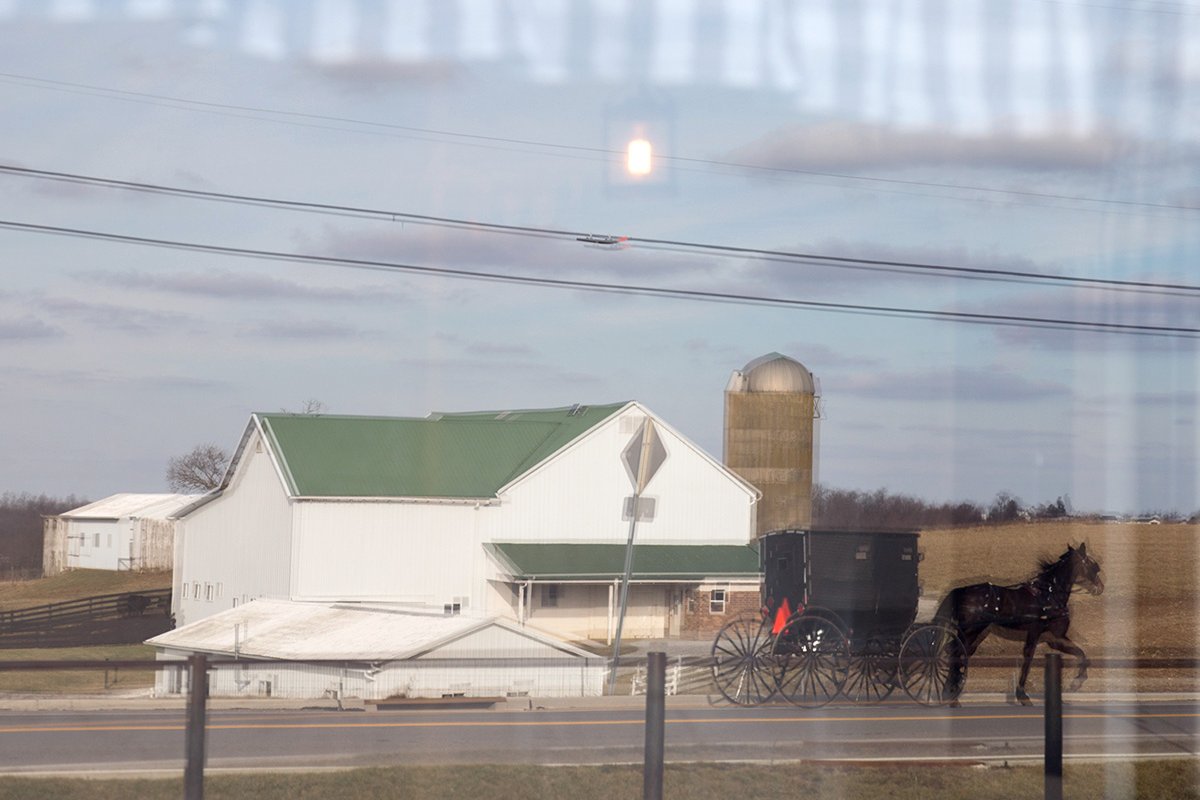
Today's Amish Are Plain, Not Simple
Comments by Stephen Colbert overlook the complexity of Amish culture in the 21st century.
By Lauren PondApril 4, 2024
Recently, Donald Trump Jr. took to X, formerly known as Twitter, to champion expanded Republican voter registration efforts in some unconventional locations: “In 2024, we need an all-of-the-above voter strategy,” he tweeted. “That means voter registration at gun shows, concerts, UFC fights – and even in Amish country.”
I learned of this tweet like I do many things political: while watching one of Stephen Colbert’s opening monologues on The Late Show. Normally, these comedic segments give me a good laugh as I’m turning in for the evening. But this time, as Colbert poked fun at Trump Jr.’s courting of Amish voters, I cringed.
“One of those things is not like the others,” the late night television host said in a singsong voice, mocking the proposed voter registration locations. “I get what you’re doing,” Colbert said, further addressing the former president’s son, “but I’m not sure the best way to reach the Amish is the internet – unless you go to their top social media sites: MilkTok and Facebarn.” The audience burst into laughter and applause.
Colbert’s comments, while tinged with truth, are unfortunate. For one thing, they gloss over significant sociopolitical developments in Amish country that suggest Trump Jr.’s voter outreach ideas are not that off-base. But they also reinforce some common misconceptions: namely, that the Amish are old-fashioned, insular technophobes. The reality is, like most religious cultures, far more complicated.
As scholars David L. McConnell and Marilyn D. Loveless explain, the Amish are Christians in the Anabaptist tradition and biblical literalists well-known for what they see as imperative separation from the world, its temptations, and its vices. Since fleeing persecution in Europe several centuries ago, they have formed settlements in thirty-two American states and four Canadian provinces. While every order and church-led district is unique, broadly speaking, the Amish are historically pacifistic and apolitical, and they typically eschew outside developments and involvement with institutions that they believe threaten their way of life, including the government. They tend to reside in rural areas, dress plainly, and emphasize faith, family, and community above most else.
One of the largest Amish settlements in the world is in northeast Ohio – about ninety minutes from where I happen to live. The Holmes County Settlement has a booming tourism industry, and like approximately four million others who make the trip annually, I dutifully visited in 2021, drawn to the region’s rolling hills, handmade wooden furniture and crafts, lush produce, and fresh baked goods. But what really caught my eye were the dozens of Amish men and women I saw tooling around on electric bicycles, often with children in tow.
You read that correctly: electric bicycles.
My existing notion of Amish culture disappeared more quickly than the cream-filled donut I had just purchased. My disbelief inspired me to do further research and start work on a journalistic project about the Amish use of technology, through which I have learned that life among the so-called “plain” people is far from simple these days.
While it is true that some Amish – such as the conservative Swartzentruber Amish, who are known to live without electricity or running water – lead relatively cloistered lives disconnected from the conveniences of modern society, many others use technology to run their businesses and day-to-day lives. The Amish are not necessarily averse to technology itself, but to its potentially harmful effects on their communities, and leaders carefully consider each development for its practicality and potential impact before it is adopted, sometimes with innovative modifications. “Digital technologies are literally and figuratively bridges that connect their separatist communities to an alternative reality that they believe has the potential to erode their religion and culture from the outside in,” Lindsay Ems writes in Virtually Amish. “Thus, decisions about technology adoption are multilayered, complex, dynamic, and contested.”
Driving cars – which can take people to far-flung and potentially unsavory locations, one of my contacts explained – is out, as are television and the public electric grid. But solar panels are permissible and present in much of Holmes County, as are developments like battery-powered electric bicycles, which serve the practical purpose of transporting the Amish shorter distances. (While many residents still use traditional horse-drawn buggies, the owner of a local e-bike store told me that the bicycles help make workday commutes through the steep hills a bit safer and less grueling.) Cell phones and the internet have even been adopted in varying degrees, and over the past year, I have corresponded with some of my contacts over email.
An electric bicycle parked at an Amish stable in Holmes County, Ohio, in 2023. Photograph by Lauren Pond.
“The Amish are evolving just like the rest of the world,” one young woman told me last spring as she prepared to ride her electric bicycle home from a stable.
Also part of this evolution, evidently, is the growing presence of politics. Elements of Trumpism, including Christian Nationalism, are appearing in some plain communities.
In a recent article for Slate, Susan Trollinger, a professor at the University of Dayton, Ohio who studies tourism in Amish communities, notes that she has taken students to the Holmes County Settlement since 2008. Like me, she was stunned by what she encountered on a recent trip: “I saw the Stars and Stripes everywhere,” she writes, describing a variety of gift store paraphernalia she saw infused with patriotic motifs: t-shirts, ball caps, decorative wreaths, candles, and even wooden crosses. “Amish Country tourism has never simply been about the plain and simple life of the Amish. But these days, sites that fuse Christian symbols and sacred texts with a brand of nationalism that celebrates masculine bravado, guns, and the military marks a further and dramatic remove from the character of Amish life."
Republicans apparently have taken notice and have made concerted efforts to court the Amish vote as part of their broader outreach to conservative Christians. Leading up to the 2020 election, a “Trump Train Parade” in Ohio featured horse-drawn buggies, and Amish men in brimmed straw hats appeared in a sea of MAGA signs at a Lancaster, Pennsylvania rally. While I have not explicitly asked my interlocutors about politics, familiar rhetoric has surfaced in our conversations, including dismissal of climate change as a political “theory.” Even more striking is that such sentiments and outreach efforts might actually translate into a surge in voter turnout – in a demographic that historically does not vote.
Hoping to understand Trump’s appeal among the Amish, in October of 2020, Justin Williams, a reporter for the Cincinnati Enquirer, returned to his hometown in Ohio’s Gallia County, where he spoke to members of that region’s growing plain community. Some said they appreciated Trump’s commitment to “American values,” he notes, and many were small business owners who thought they had benefited from the former president’s economic policies. But ironically, in a political climate so heavily influenced by televised and tweeted rhetoric, a key part of Amish support for Trump was their culture’s rejection of such technologies. “They don't experience all the vitriol, angst and anger on the networks and social media about Trump and this election,” Williams writes. “They couldn't care less about Trump's tweets.”
Likewise, they probably couldn’t care less about Colbert’s monologue. The tropes it perpetuates are nonetheless problematic. The Amish are arguably one of the most recognizable but least understood religious communities in the country – and while Colbert is correct that Trump Jr. likely won’t reach them on social media platforms, this doesn’t mean that Amish political involvement, among other aspects of plain culture, can be so easily dismissed or simplified.
Featured image: A storefront reflection of an Amish buggy in Holmes County, Ohio, in 2022. Photograph by Lauren Pond.



